Now & New
Toukasan Yukata Festival: Traditional Garb in the Limelight
In Japan, the concept of a Big Three is a constantly recurring theme: you’ve got the Three Views of Japan (Matsushima in Miyagi Prefecture, Amanohashidate in Kyoto Prefecture, and Itsukushima Shrine in our very own Hiroshima Prefecture) and the Three Festivals of Japan (the Kanda Festival in Tokyo, the Gion Festival in Kyoto, and the Tenjin Festival in Osaka), among countless other lists. While none of Japan’s major festivals is located in Hiroshima Prefecture, Hiroshima City alone boasts no meager number of celebrations throughout the year that are beloved by locals and visitors alike. The first of these in a year is the ゆかたできん祭 (ゆかたできんさい – “Come-on-down-in-your-yukata Festival”), usually referred to as とうかさん (Toukasan), the name of the shrine around which the festival is based.
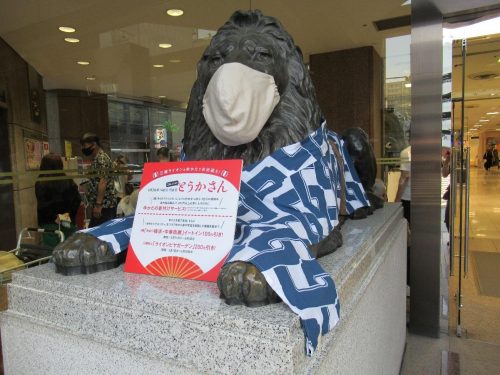
Toukasan places a considerable emphasis on attendance and participation while wearing yukata (traditional Japanese summer kimono for men and women), and as it is held on the first Friday, Saturday, and Sunday of June every year, it is regarded as the first summer festival in the city as the dates are roughly in line with the start of season (in other words, yukata weather). In modern times, fewer people have been wearing yukata to summer festivals (usually girls and women nowadays), and due to their limited applicability (almost nobody wears it outside of festivals and ceremonies), lots of Japanese youth don’t even own a yukata. However, with the festival itself, the MCs for the events, fellow festival goers, and even the Mitsukoshi bronze lion statue donning one for the weekend, visitors would be hard pressed to resist the temptation to buy a yukata and wear it every summer.
Toukasan Reboot
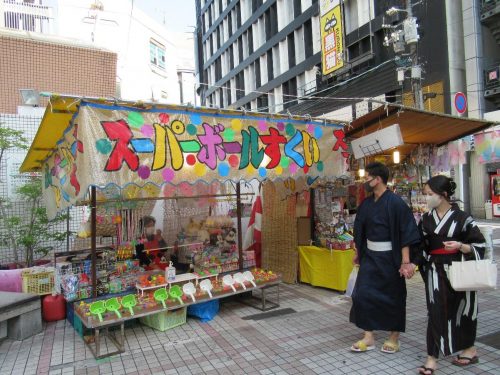
It goes without saying that Toukasan is based in and around the shrine, located in southern Mikawa-cho downtown. Under normal circumstances, the segments of Peace Boulevard and Chuo Avenue closest to the Toukasan shrine would be packed to the brim with food stalls, carnival games, and festival goers to the point where sometimes, attending the festival feels more like a forced march than a cause for celebration. The festival atmosphere would spill into Shintenchi Park just north of the shrine where there would be a raised scaffold from which lanterns hang, music plays, and an MC sings and makes announcements. Visitors, many of whom would don yukata, would be ready to dance the night away around the luminous scaffold while enjoying shaved ice, ramune (old-timey glass bottles of soda pop with a marble inside), and alcoholic beverages in between sessions. Sadly, the traditional Bon dancing bit was cancelled, and in its place, additional venues at Alice Garden and Shareo each hosted a stage area where only a few predetermined groups would dance for people.
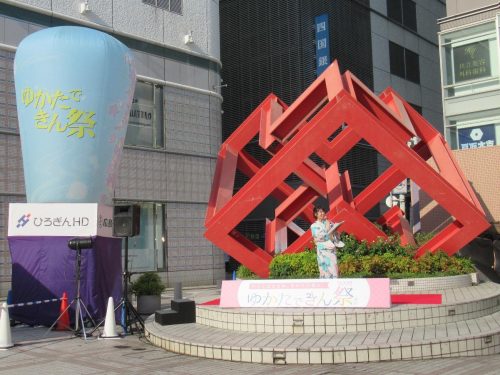
As with every other festival that has been held during the pandemic, hand sanitizer dispensers were strategically placed throughout the festival sites, and mask policy was strongly advocated for all visitors. Only performers and MCs didn’t have to wear them, and I’m confident they tested negative for COVID-19 beforehand. However, just because the traditional festival site and Bon dance were absent didn’t mean there was no reason to break out the old yukata, as the few festival stands and makeshift bamboo arch in Alice Garden still made fine backdrops for commemorative photos. The woman below seemed to be some local celebrity or renowned TV personality, since everyone on site wanted to take a picture of her and there was another lady with a clipboard watching over her and ushering her elsewhere after the photographers dispersed. Naturally, I obtained permission to photograph her under the bamboo arch as I believed her likeness represented Toukasan better than I or anyone else there in a yukata could.
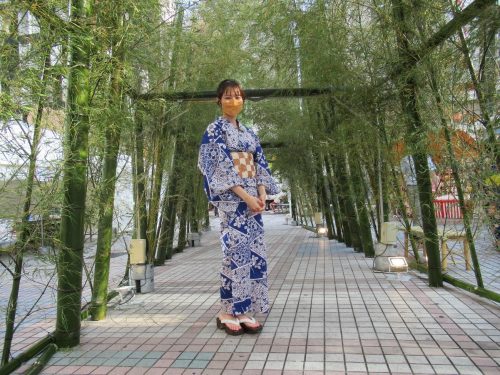
According to the MC, the opening ceremony performances at Alice Garden wouldn’t begin for a while, so I made my way over to the Shareo site to scope out the situation there. The central hub area of the underground shopping mall periodically hosts events such as temporary flea markets, themed conventions, and dining space during holiday seasons. For Toukasan this year, Shareo was home to several tables where guests can learn to make one of five traditional Japanese trinkets by hand, as well as a central stage where performances took place. I was just in time to see the opening kick-off show, a brief number put on by the Chari Dance School. The three women were dressed in yukata reminiscent of Japan’s past, but shorter in length and stylized to reflect the country’s modernization.
Following their performance, I walked around the craft workshop stations to see what everyone was up to. Visitors were able to create a different object with an expert standing by at each table to assist in the process, and every trinket cost the same to make. Options included ink art calligraphy, mask painting, and mizuhiki, the art of bending colored cord made from twisted rice paper into all sorts of shapes for decoration. The first thing that comes to my mind when I see mizuhiki is the cord wrapped around a congratulatory envelope filled with money (for birthdays, weddings, etc.), but this lady seemed to be tying the cord into knots to make a charm that can be hung somewhere.
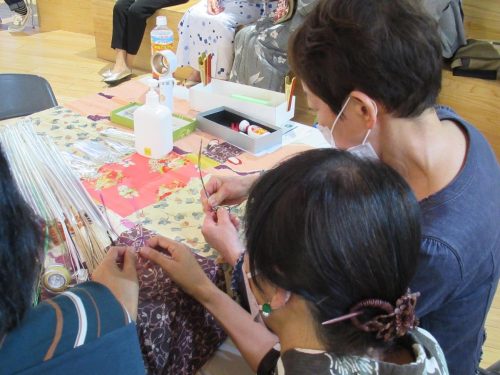
After inquiring about each craft at the reception counter, I figured that my preference would be for the fan-dyeing experience. Not only does it take the least amount of time and expertise to complete, but the fan would also be the most useful object of them all on account of the weather. Additionally, depending on the design, one’s fan could pair well with one’s yukata, and when dancing at festivals, the handle can be inserted into the backside of the obi (belt-like fabric that wraps around the yukata to keep it shut) for further accentuation of one’s outfit.
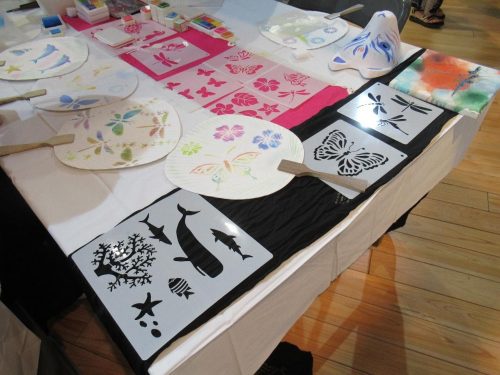
As I made my way around the tables, I noticed one craft option that wasn’t listed on the promotional poster: decorating a plaster maneki-neko (beckoning cat statuette). It seemed the youth at this table were quite passionate about coloring as at least one of the maneki-neko bore a strong resemblance to a currently popular anime character. Much as it made me want to color and bring my own maneki-neko, I had no other use nor any place to put it at home, so my choice of the dyed fan remained adamant.
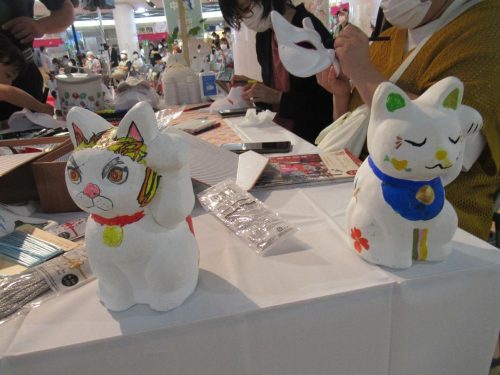
Dancing in the Rain
Unfortunately, on the first day of Toukasan I had work in the evening, so I was only able to check out the opening ceremony at the above sites. The only day I could make it to the festival in earnest was on Sunday, the last day, and the weather was anything but sunny. The crafts and shows at the Shareo site actually ended on Saturday, the 4th, so I could only avail myself of the Alice Garden site, which in retrospect was the more entertaining one. There was a small craft station with fewer options, resources, and participants, but a lot more performances happening on this stage over the weekend. I came around midday to catch these little angels in modified yukata dancing to some pop music.
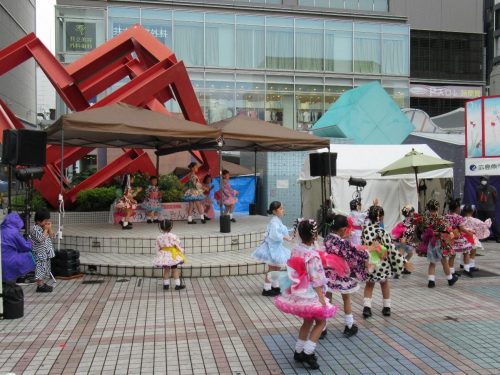
While there was no need to cover the dancers on the first day, tarps were put up today to shield at least some of the performers on the raised stage area. On the other hand, spectators simply had to watch out in the open and carry their own umbrellas. Another option was to duck down underneath the craft tent under the pretense of contemplating making a craft, though there were some underneath that tent who watched the shows and did nothing else. I figured that since I would be here watching performances for a long time and can see everything from the craft table, I might as well take my time participating in a traditional craft experience.
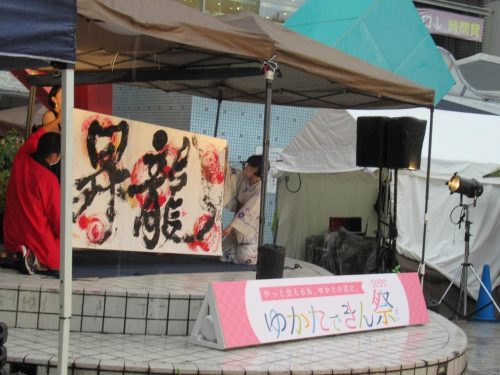
After a couple of dance troupes, there was a woman who put on a calligraphy performance. A man sat in a chair in the corner playing a shamisen while the woman made bold strokes with a ginormous brush on a broad sheet of rice paper on the ground. When she finished, her assistants proudly held up the finished product to enrapture the audience with the artist’s graceful penmanship. The kanji she wrote were 界龍 (かいりゅう – world dragon), referring to her desire for the world to spring into the heavens and navigate them freely and courageously like a dragon would. In other words, she was praying for the entire world’s recovery from this pandemic so that the global population can get on with the usual lives and achieve the dreams they desire.
Of course, if traditional Japanese culture isn’t your cup of tea, fret not! Lots of dancers were performing to contemporary J-pop tunes and anime songs, so otakus with a love for modern Japan will still have something to look forward to. These kids donned Tanjiro Kamado’s iconic checkered cowl while dancing to the opening theme for season one of the critically acclaimed Demon Slayer: Gurenge.
Duck and Weave
While the calligrapher was going berserk with the brush and all those wannabe Tanjiros were shadowboxing in the rain, I remained ducked down under the tent trying to create a personal masterpiece with bamboo. Visitors that day could only create one of three things: bamboo rings, a bamboo necklace, or a potted plant minus the pot (i.e., a plant rooted in a ball of dirt). They all cost the same, so I went for the least-messy, most worth-my-money necklace, which was essentially a bunch of bamboo rings strung together. The man at the counter first walked me through the process of making a single ring, and after that, I was off to the races! The most crucial element to these bamboo rings is a moist strip of bamboo; a dry strip would snap when bent, but today’s rain was perfect for moistening all I would need for the necklace.
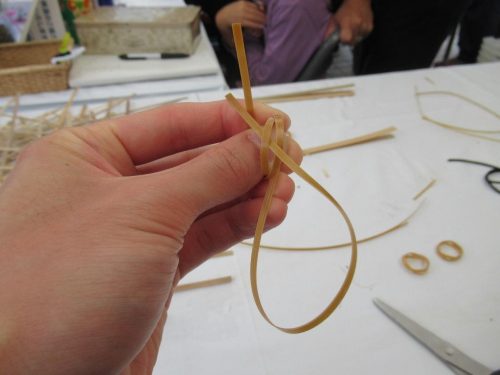
The first step involves coiling the strip around twice, leaving a few centimeters poking out on one end of the coil and using the remainder of the strip to bring up and pass through the openings between the coil loops. Every time I passed the strip through, I would pull on both ends of the strip to tighten the woven structure. From that, another opening would appear further along the ring, so I repeated the passing-through-the-hole step two more times, retightening the ring each time. Finally, when the woven ring shape was constructed and stable, I used scissors to snip off the excess ends and presto: one bamboo ring complete!
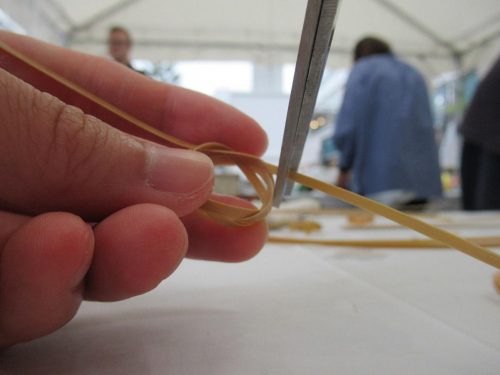
The first step involves coiling the strip around twice, leaving a few centimeters poking out on one end of the coil and using the remainder of the strip to bring up and pass through the openings between the coil loops. Every time I passed the strip through, I would pull on both ends of the strip to tighten the woven structure. From that, another opening would appear further along the ring, so I repeated the passing-through-the-hole step two more times, retightening the ring each time. Finally, when the woven ring shape was constructed and stable, I used scissors to snip off the excess ends and presto: one bamboo ring complete!
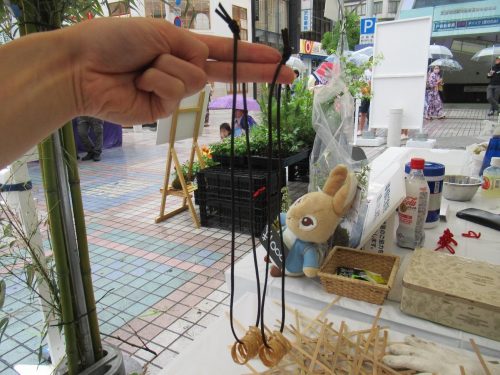
Moment of Joy: Full Belly, Full Heart
By the time I had completed both bamboo necklaces, I had also had my fill of watching shows at Alice Garden, so I decided to head south in the direction of the Toukasan shrine to survey the scene and get in my annual prayer. From the day Toukasan began, I was only expecting the few stands in Alice Garden and nowhere else, but as I approached the shrine from the west, the sight before my eyes blew my projection out of the water!
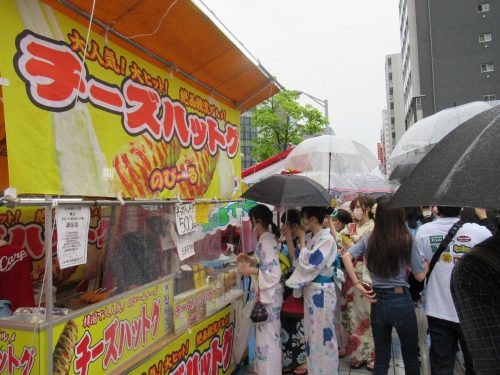
An endless parade of people was flowing past the innumerable food stands lined up along Chuo Avenue, past the shrine down south and winding onto Peace Boulevard, itself also saturated with festival food options. It was almost as if the pandemic was over (we just need the Bon dance), and although the density of people was daunting for someone who had grown accustomed to social distancing, this situation raised my hopes for future festivals this year.
The Namesake Shrine
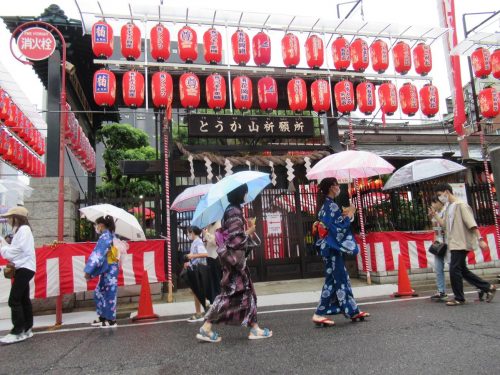
I held off on the festival food and prioritized praying at the shrine, which I believe to be the actual point of the Toukasan festival. Festival goers in yukata carrying umbrellas walked to and fro around the shrine grounds, and some even stopped to consume their carnival fare right by the side gate. Though I wasn’t looking forward to umbrella fighting with others while waiting to pray, I bit the bullet and got in line.

If it was any consolation, the long wait gave me lots of time to get my coin ready to toss into the prayer box, which took longer than usual on account of having to hold my umbrella with my chin while I reached for my wallet. I was simply thankful to be able to take part in this ritual again for the first time since 2019, since the festival was canceled the past two years and the prayer portion was made an online thing. As soon as I threw my money into the box and finished praying, I swiftly left the shrine grounds and made my way towards the food stalls on Peace Boulevard. To be honest, at this point the rain combined with the crowds was making me rather irritable, so I minimized my browsing time by buying a chocolate taiyaki (fish-shaped pastry with a sweet filling) to go and eating it at home. I would show you what it looks like on the outside, but it just looks like every other taiyaki and it’s what on the inside that counts anyway.

Disappointing as it was that there was no Bon dance this time around, this year’s Toukasan was still not too shabby for a Hiroshima that’s still in the process of reawakening from COVID-19. Had I been free to party on the first two days, I probably would have seen and enjoyed more of the festival, but regrettably, I could only deeply explore it on the one rainy day, which was not at all conducive to the wearing of yukata. Mark my words, though: next year, when all restrictions loosen up and the Bon dance returns, I will open up my entire weekend and make the most out of all dry days to dance myself sore. Until that time comes, I’m going to keep my chin up as I hit up the remaining two of Hiroshima’s Great Festivals. Toukasan may be out of the limelight for now, but hold on to your yukata, because the next Great Festival will take the stage later this summer!
Written by the Joy in Hiroshima Team
